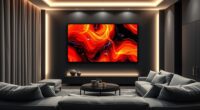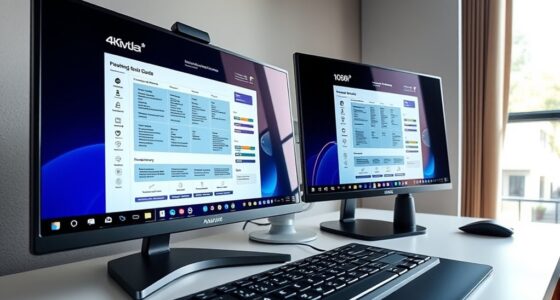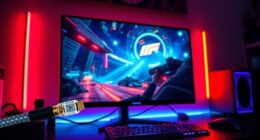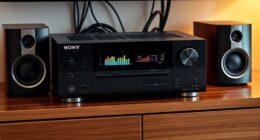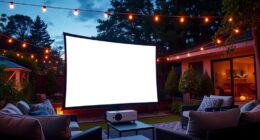When adopting HDR formats and tone mapping, you might overlook hidden costs like hardware upgrades, increased storage, and bandwidth needs, which can strain your budget. Compatibility issues and format restrictions may force frequent hardware or software updates, while overprocessing can cause artifacts and quality loss. Plus, longer processing times reduce workflow efficiency. Being aware of these challenges helps you plan better. Keep going to discover ways to manage these hidden expenses effectively.
Key Takeaways
- Upgrading hardware to support new HDR formats incurs significant costs and ongoing expenses for compatibility and calibration.
- Higher storage and bandwidth demands of HDR content increase infrastructure costs and complicate distribution.
- Poor tone mapping can introduce artifacts and reduce image quality, risking costly rework and calibration efforts.
- Licensing fees for specialized HDR formats and software add hidden, recurring expenses that can escalate over time.
- Evolving HDR standards require frequent hardware and software updates, leading to unforeseen investment and maintenance costs.
Increased Hardware Requirements and Compatibility Challenges

While HDR formats promise richer visuals, they also demand more from your hardware. You might face hardware compatibility issues, as not all devices support the latest HDR standards. Older monitors, graphics cards, and media players often have format limitations, preventing you from enjoying the full benefits of HDR content. Upgrading hardware becomes necessary, which can be costly and inconvenient. Even if your hardware supports HDR, it must meet specific specifications to handle higher bit depths and color ranges. Without proper compatibility, you risk experiencing degraded image quality or playback problems. Ensuring your hardware aligns with HDR format requirements is essential to avoid these hidden costs. Be prepared for potential upgrades to fully enjoy HDR’s immersive visuals without technical hiccups. Additionally, understanding bedroom design principles can help you optimize your space for better viewing experiences when upgrading your setup.
Higher Storage and Bandwidth Consumption
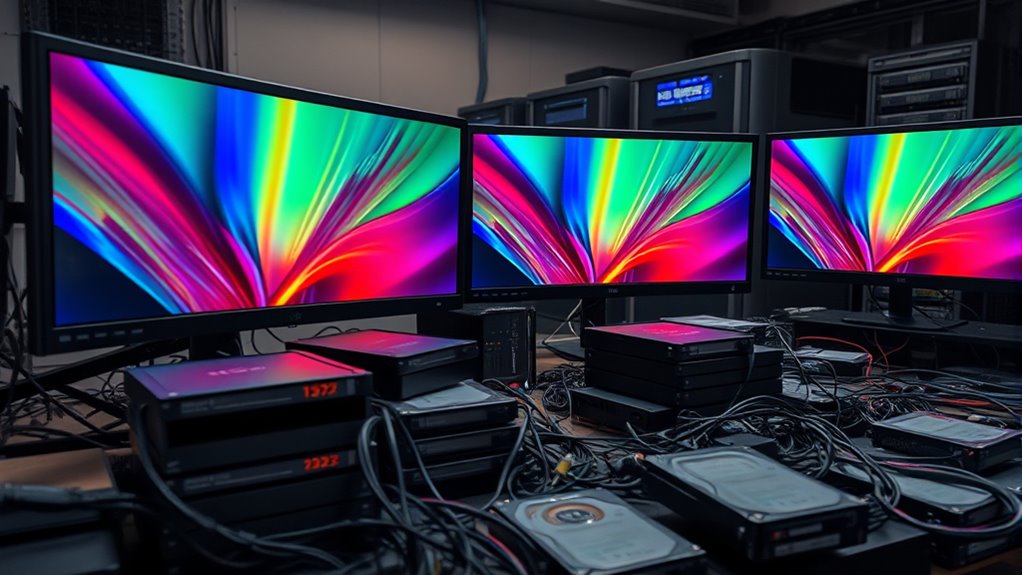
HDR content typically requires substantially more storage space and bandwidth than standard formats. This increased storage overhead means your media files are larger, which can strain your storage solutions and lead to higher costs. The bandwidth impact is also significant; streaming HDR videos demands more data transfer, resulting in buffering issues and increased data consumption for viewers. These demands can challenge existing network infrastructure, especially if you’re scaling up content delivery or supporting multiple users simultaneously. As a result, you may need to upgrade storage devices or invest in faster internet connections to handle the higher data loads. This added cost and complexity are often overlooked but are essential considerations when adopting HDR formats. Managing these factors is crucial to avoid performance bottlenecks and unexpected expenses. Additionally, using high-quality compression can help mitigate some of these storage and bandwidth challenges.
Potential Quality Loss During Tone Mapping Processes

Tone mapping, a crucial step in displaying HDR content on standard screens, can inadvertently cause quality loss if not executed carefully. Poor tone mapping may reduce color accuracy, leading to dull or oversaturated images. It can also introduce artifacts such as banding, posterization, or halos, which detract from visual fidelity. To minimize these issues, focus on:
Poor tone mapping can cause color loss and artifacts, harming HDR image quality.
- Applying adaptive algorithms that preserve natural tonal progressions
- Ensuring proper calibration to maintain accurate color representation
- Using techniques that prevent artifacts during dynamic range compression
Additionally, understanding the importance of professional voice actors can help create more engaging and credible visual narratives that complement the tone mapping process.
Extended Processing Times and Reduced Workflow Efficiency
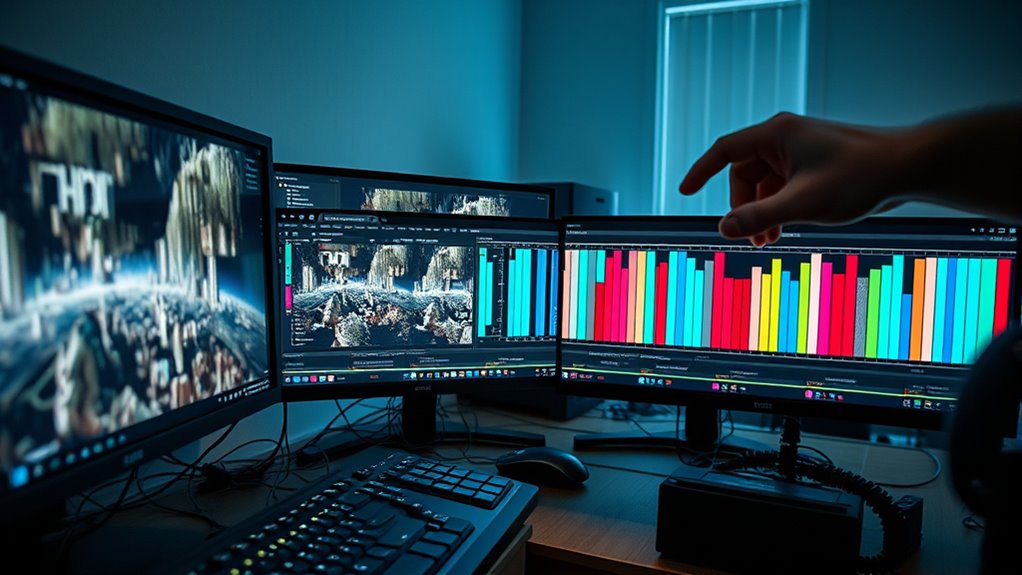
When working with HDR formats, you’ll notice longer rendering times that can slow down your entire project. These extended processing periods often create workflow bottlenecks, making it harder to meet deadlines. As a result, your efficiency drops, and you may spend more time waiting than working. Additionally, complex tone mapping can introduce processing overhead, which further impacts overall productivity.
Increased Rendering Duration
Although HDR formats and tone mapping can enhance visual quality, they often lead to longer rendering times that slow down your workflow. This increased rendering duration can hinder real-time editing, forcing you to wait longer for previews and final outputs. The extended processing impacts viewer perception, as delays reduce your ability to make quick adjustments and see immediate results. To manage this, be aware that:
- Complex tone mapping algorithms require additional computation time
- Higher resolution HDR content demands more rendering power
- Multiple adjustments extend total processing duration
- Utilizing optimized workflows can help mitigate some of these delays by streamlining processing steps
These factors can frustrate your workflow, making it harder to maintain efficiency and timely delivery. By understanding these hidden costs, you can better plan your projects and optimize your process to minimize delays.
Workflow Bottlenecks
Extended processing times caused by HDR formats and tone mapping can create significant workflow bottlenecks, reducing your overall efficiency. These delays slow down your color grading process and limit your creative flexibility. As you wait for rendering to complete, your productivity drops, and project deadlines become tighter. To better understand these bottlenecks, consider the following:
| Issue | Impact | Solution |
|---|---|---|
| Extended render times | Slows down editing and review | Optimize settings, hardware upgrades |
| Complex tone mapping tasks | Consumes more processing power | Simplify tone mapping workflows |
| Large HDR files | Increases storage and transfer time | Use optimized formats and compression |
| Software incompatibilities | Causes delays and rework | Choose compatible editing tools |
| Limited hardware resources | Bottlenecks entire workflow | Upgrade hardware or streamline steps |
| Color grading techniques | Can influence processing times and quality | Apply efficient grading methods |
Reducing these bottlenecks enhances your creative flexibility, making color grading faster and more efficient.
Costly Upgrades and Investment in Professional Equipment

Upgrading to professional HDR equipment can hit your budget hard with expensive hardware and software licensing costs. These investments often require ongoing expenses for updates and maintenance to stay current. As a result, your initial gains may come with a significant long-term financial commitment. Proper maintenance, such as regular cleaning and inspecting components, can help extend the lifespan of your equipment and prevent costly repairs down the line, ultimately protecting your investment in professional equipment.
Expensive Hardware Requirements
Implementing HDR formats and advanced tone mapping often demands substantial hardware investments, which can quickly become costly. You may need to upgrade your existing equipment to handle higher data loads and processing demands. These upgrade expenses include investing in powerful GPUs, high-capacity storage solutions, and professional-grade displays. To keep up, you might find yourself facing: – Costly hardware upgrades to meet processing needs – Frequent replacements as technology advances – Increased energy and maintenance costs. Additionally, staying current with hardware demands is essential but can considerably elevate your overall project costs. Without the right hardware, your system may struggle with rendering and playback, undermining your investment.
Software Licensing Costs
Adopting HDR formats and advanced tone mapping often requires purchasing specialized software licenses, which can be expensive and frequently need renewal or upgrades. These software licensing costs add up over time, especially when dealing with format restrictions that limit your options or force you into costly upgrades. Some licenses only support specific HDR formats, meaning you might need to buy multiple licenses or switch software altogether. This can markedly inflate your overall investment in professional equipment. Additionally, staying current with software updates to maintain compatibility and access new features often incurs extra fees. These licensing expenses can quickly become a hidden financial burden, making it essential to evaluate the long-term costs associated with format restrictions and licensing renewal cycles before committing.
Ongoing Upgrade Expenses
Since HDR technology evolves rapidly, staying current often means making costly upgrades to your equipment and software. These expenses can impact your ability to maximize content monetization and maintain high user engagement. Upgrading professional equipment, like high-end monitors, cameras, and tone mapping tools, ensures your content remains visually compelling and competitive. You’ll also need to update editing software to support the latest HDR standards, which can be expensive over time. Additionally, ongoing training and calibration are necessary to keep your workflow optimized. Investing in new hardware to support advanced HDR formats, along with proper calibration, is essential for maintaining consistent image quality. Regular software updates to stay compatible with evolving standards, and training costs to support your workflow, are also crucial to sustain high-quality output.
Limited Content Availability and Format Support
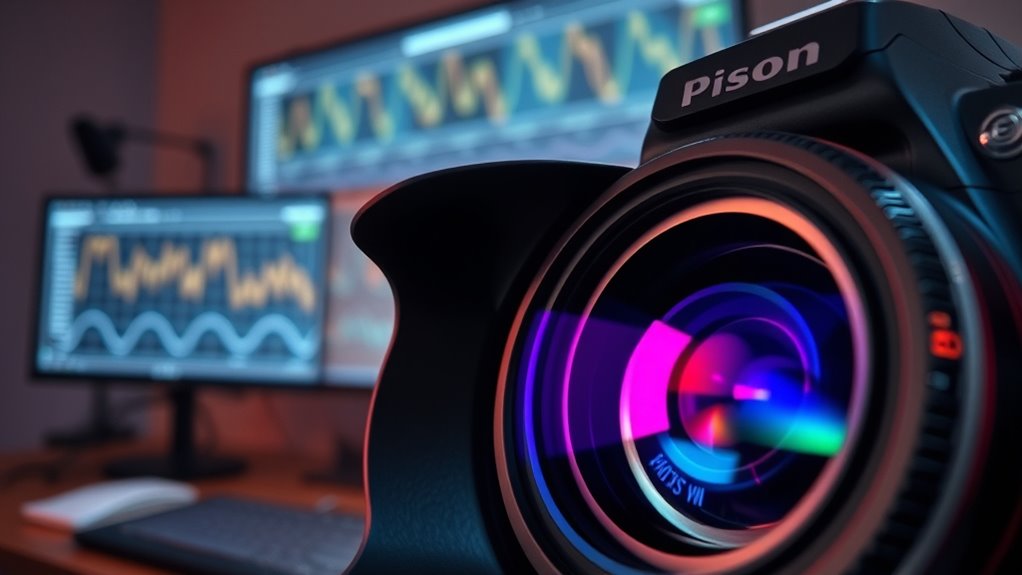
Have you ever struggled to find HDR content compatible with your device or preferred format? Limited content availability can be a frustrating obstacle, often due to content gaps and format limitations. Not all streaming services or broadcasters support every HDR format, meaning you might encounter incompatible videos or require multiple players. This fragmented support increases the complexity of enjoying HDR content seamlessly. Additionally, some formats may have fewer titles or less updated libraries, leaving you with fewer options. These content gaps and format limitations can force you to compromise on quality or spend extra time searching for compatible content. Furthermore, the variability in color accuracy across different formats can impact the overall viewing experience. Ultimately, this limited support adds hidden costs—both in time and money—making it more challenging to fully enjoy the benefits of HDR technology.
Challenges in Achieving Consistent Color Accuracy
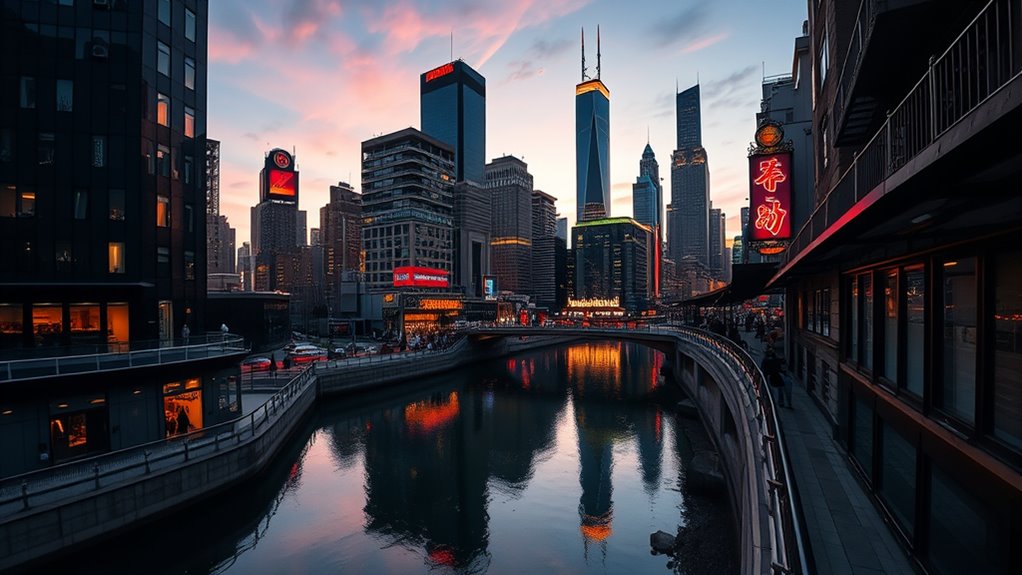
Achieving consistent color accuracy across HDR content remains a significant challenge due to variations in display capabilities and processing techniques. You need to perform proper color calibration to ensure hues and luminance match intended standards. Without precise display calibration, colors can appear oversaturated, undersaturated, or distorted, reducing visual fidelity.
Key challenges include:
- Inconsistent color reproduction from different displays due to hardware differences
- Variability in tone mapping algorithms that affect color rendering
- Difficulties in maintaining uniform calibration across multiple devices
To minimize these issues, you should regularly calibrate your displays, use professional calibration tools, and verify color accuracy with standardized test patterns. Addressing these factors helps ensure that your HDR content maintains intended colors and visual quality.
Risks of Overprocessing and Visual Artifacts

Overprocessing HDR content through aggressive tone mapping or excessive sharpening can introduce visual artifacts that degrade image quality. Banding artifacts often appear as smooth gradients turning into visible steps, disrupting the seamless look you want. Posterization issues, where colors shift abruptly instead of blending smoothly, also become more prominent. These artifacts distract viewers and reduce the overall realism of your images. Pushing HDR images too far can cause loss of detail in highlights and shadows, making scenes look unnatural. To avoid these problems, apply tone mapping and sharpening conservatively, preview results on different screens, and use tools that minimize artifact creation. Striking the right balance preserves image integrity and prevents your content from suffering the typical pitfalls of overprocessing.
Frequently Asked Questions
How Can I Optimize HDR Settings for Different Display Types?
To maximize HDR settings for different display types, start with proper display calibration to guarantee accurate color and brightness. Adjust contrast settings to match each display’s capabilities, enhancing detail in dark and bright areas. Test your settings across various HDR content, fine-tuning contrast adjustment as needed. This approach ensures superior visual quality, reduces artifacts, and provides a consistent viewing experience tailored to each display’s unique characteristics.
Are There Affordable Alternatives to High-End HDR Hardware?
Yes, you can find budget options and entry level solutions for HDR hardware. Look for affordable monitors and TVs that support HDR10 or Dolby Vision, which offer good quality without breaking the bank. Consider upgrading your existing equipment with affordable external devices or software that enhance HDR performance. While these options may not match high-end hardware, they provide a solid HDR experience on a budget, making HDR more accessible.
What Are the Best Practices for Managing HDR Storage Efficiently?
Managing HDR storage efficiently is essential to avoid chaos. You should prioritize metadata management to keep track of color info and tone mappings without clutter. Compression techniques like lossy or lossless compression cut down file sizes drastically, saving space while maintaining quality. Regularly organize your files, delete unnecessary versions, and automate backups. These strategies turn massive HDR libraries into sleek, manageable collections, preventing storage nightmares and keeping your workflow smooth and stress-free.
How Do I Balance Tone Mapping Quality With Processing Speed?
To balance tone mapping quality with processing speed, you should optimize your algorithms by selecting the right tone mapping operator that offers a good trade-off between quality and efficiency. Use hardware acceleration when possible, and adjust parameters to reduce computational load without sacrificing visual fidelity. Prioritize real-time processing needs, and consider pre-processing or downscaling images to speed up tone mapping while maintaining acceptable quality.
Can Software Solutions Mitigate Hardware Upgrade Costs for HDR?
Like a skilled diplomat, software solutions can often bridge the gap caused by hardware limitations. By ensuring software compatibility and seamless hardware integration, you can reduce the need for costly upgrades. Up-to-date software can optimize existing hardware, enhancing HDR performance without additional expenses. This approach allows you to leverage your current investment, making HDR workflows more efficient and cost-effective while avoiding the temptation to constantly chase new hardware.
Conclusion
Managing HDR formats and tone mapping can be tricky, often costing more time and money than expected. You might face compatibility issues, quality loss, or costly upgrades that drain resources. Remember, “a penny saved is a penny earned,” so weigh the hidden costs carefully. By understanding these challenges, you can avoid pitfalls and make smarter choices, ensuring your content stays stunning without breaking the bank.

